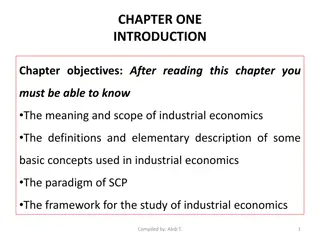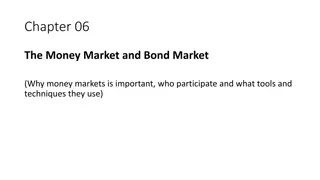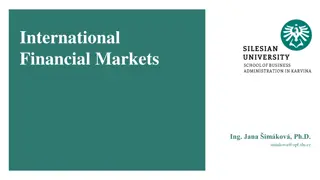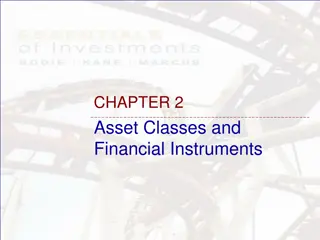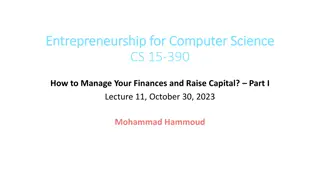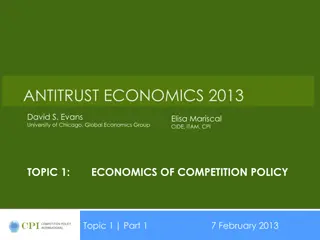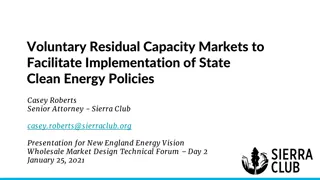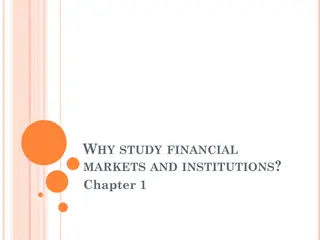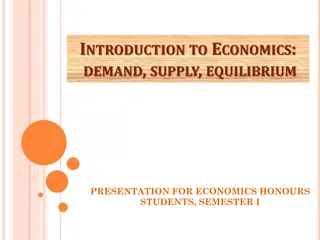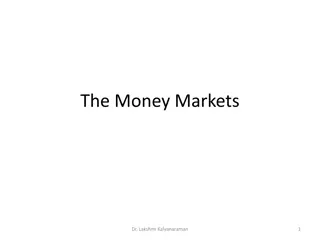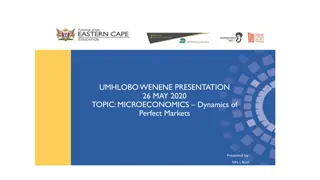Understanding Financial Economics and Its Importance in Markets
Financial economics is a branch of economics focused on the distribution of resources in uncertain markets. It involves making decisions considering future events and creating models to analyze variables affecting decisions. Key aspects include working out portfolio risks and utilizing financial instruments. The financial system comprises money, financial instruments, markets, institutions, and services. Its functions include ensuring efficient payment mechanisms and facilitating risk transformation through diversification. Financial structure refers to the debt-equity mix used by companies for financing operations.
Download Presentation

Please find below an Image/Link to download the presentation.
The content on the website is provided AS IS for your information and personal use only. It may not be sold, licensed, or shared on other websites without obtaining consent from the author. Download presentation by click this link. If you encounter any issues during the download, it is possible that the publisher has removed the file from their server.
E N D
Presentation Transcript
FINANCIAL ECONOMICS BY DR.G.YOGANANDHAM, ASSOCIATE PROFESSOR & HEAD, DEPARTMENT OF ECONOMICS, THIRUVALLUVAR UNIVERSITY , (A STATE UNIVERSITY), VELLORE-632115, TAMILNADU. WELCOME
FINANCIAL ECONOMICS Financial of distribution of resources in markets in which decisions are made under uncertainty. Financial decisions must often take into account future events, whether those be related to individual stocks, portfolios or the market as a whole. Financial economics often involves the creation of sophisticated models to test the variables affecting a particular decision. economics that is a branch use economics analyzes the and
IMPORTANT OF FINANCIAL ECONOMICS Financial economics has many aspects. Two of the most An important part of finance is working out the total risk of a portfolio of risky assets, since the total risk may be less than the risk of the individual components. Financial economics microeconomics and concepts. important are: builds basic heavily accounting on
THE PARTS TO THE FINANCIAL SYSTEM Money. Money is used as a medium to buy goods & services. Financial Instruments. Financial Instruments are formal obligations that entitle one party to receive payments or a share of assets from another party. Financial Markets. Financial Institutions. Central Banks.
COMPONENTS OF FINANCIAL SYSTEM A modern financial system may include banks (public sector or private sector), financial markets, financial instruments, and financial services. Financial systems allow funds to be allocated, invested, or moved between economic sectors. They enable individuals and companies to share the associated risks.
FUNCTION OF FINANCIAL SYSTEM The financial system ensures the efficient functioning of the payment mechanism in an economy. All transactions between the buyers and sellers of goods and services are effected smoothly because of financial system. Financial system helps in risk transformation by diversification, as in case of mutual funds.
STRUCTURE OF FINANCIAL ECONOMICS Financial structure refers to the mix of debt and equity that a company uses to finance its operations. It can also be known as capital structure. Private and public companies use the same framework for developing their financial structure but there are several differences between the two.
FINANCIAL STRUCTURE Financial structure refers to the mix of debt and equity that a company uses to finance its operations. It can also be known as capital structure. Private and public companies use the same framework for developing structure but there between the two. Financial managers use the weighted average cost of capital as the basis for managing the mix of debt and equity. Debt to capital and debt to equity are two key ratios that are used to gain insight into a company s capital their financial differences are several structure.
ROLE OF FINANCIAL ECONOMICS Financial economics is a branch of economics that analyzes the use and distribution of resources in markets in which decisions are made under uncertainty. Financial decisions must often take into account future events, whether those be related to individual stocks, portfolios or the market as a whole.
UNIT 1 CAPITAL MARKET Capital Market, is used to mean the market for long term investments, that have explicit or implicit claims to capital. Long term investments refers to those investments whose lock-in period is greater than one year. In the capital market, both equity and debt instruments, such as equity shares, preference shares, debentures, zero-coupon bonds, secured premium notes and the like are bought and sold, as well as it covers all forms of lending and borrowing. Capital Market is composed of those institutions and mechanisms with the help of which medium and long term funds are combined and made available to individuals, businesses and government. Both private placement sources and organized market like securities exchange are included in it.
FUNCTIONS OF CAPITAL MARKET Mobilization of savings to finance long term investments. Facilitates trading of securities. Minimization of transaction and information cost. Encourage wide range of ownership of productive assets. Quick valuation of financial instruments like shares and debentures. Facilitates transaction settlement, as per the definite time schedules. Offering insurance against market or price risk, through derivative trading. Improvement in the effectiveness of capital allocation, with the help of competitive price mechanism.
PRIMARY MARKET Otherwise called as New Issues Market, it is the market for the trading of new securities, for the first time. It embraces both initial public offering and further public offering. In the primary market, the mobilization of funds takes place through prospectus, right issue and private placement of securities.
TYPES OF ISSUE OF SECURITIES IN PRIMARY MARKET
SECONDARY MARKET Secondary Market can be described as the market for old securities, in the sense that securities which are previously issued in the primary market are traded here. The trading takes place between investors, that follows the original issue in the primary market. It covers both stock exchange and over-the- counter market.
TRANSACTION COST Meaning : A transaction cost is any cost involved in making an economic transaction. For example, when buying a good or buying foreign exchange, there will be some transaction costs (in addition to the price of the good. The cost could be financial, extra time or inconvenience. Definition: The total cost of buying or selling an asset, including commission, stamp duty and other fees or taxes. More generally, the incidental or procedural costs of executing any business transaction.
EXPLANATION OF TRANSACTION COST Transaction costs are expenses incurred when buying or selling a good or service. In a financial sense, transaction costs include brokers' commissions and spreads, which are the differences between the price the dealer paid for a security and the price the buyer pays.
TRANSACTION COST AND ANALYSIS Search & Information Costs: these are the costs involved in determining that the required product is available on the market, which has the best price, etc. Bargaining & Decision Costs: the costs required to come to a mutually-acceptable agreement, drawing up the contract, etc. Policing & Enforcement Costs: the costs required to make sure that the other party does not veer from the terms of the contract, and taking the necessary or appropriate action if the other party violates those terms.
BREAKING DOWN TRANSACTION COSTS The transaction costs to buyers and sellers are the payments that banks and brokers receive for their roles. There are also transaction costs in buying and selling real estate, which include the agent's commission and closing costs, such as title search fees, appraisal fees and government fees. Another type of transaction cost is the time and labor associated with transporting goods or commodities across long distances.
FISHER SEPARATION THEOREM This theorem demonstrates that by assuming utility maximizing and perfectly rational owners, managers of the firms should follow only one criteria when pursuing the profit- maximizing strategy invest in NPV-positive projects. In perfect capital markets the production decision is governed solely by the aim to maximize wealth without regarding subjective preferences that govern the individuals consumption decisions The optimal production (investment) decision can be separated from the individual utility.
ASSUMPTIONS 1) Capital markets areperfect Agents are perfectly rational and they pursue utilitymaximization. There are no direct transaction costs, regulation or taxes, and all assets are perfectly divisible. Perfect competition in product and securities markets. All agents receive information simultaneously and it is costless. The informationis either certain orrisky. 2)An arbitrary number of agents are endowed with some initial good. This good mayeither be consumed today or be invested today and transformed into consumptiontomorrow. 3)The agents have different but monotonous preferences, and they exhibit decreasing marginalutility.
INVESTMENT AND CONSUMPTION - UTILITY U(C0) The utility for an individual increases with consumption. We always prefer more to less and are greedy (the marginal utility is positive). Each increment in utility for each extra consumption is smaller and smaller (the marginal utility is decreasing). This means that the second derivative of the utility function is negative. Consumption, C0
INVESTMENT AND CONSUMPTION TRADE-OFF U(C1) U(C0,C1) A. C1 B. U(C0) This figure shows the utility in two dimensions: utility of consuming at time zero and utility of consuming at time one. The dotted lines represent indifference curves. All points along a dotted line are on the same level on the y-axis,having Cthe same utility. 0
INDIFFERENCE CURVES If placing the indifference curves for a single individual in the consumption plane, each indifference curve to the right means higher utility. An individual would prefer to reach a difference curve in the upper right of the figure. An individual is indifferent between consumption pattern A andB. C1 A C1a B C1b C0 C0a C0b
INDIFFERENCE CURVES At each point along the indifference curve the tangent is called the marginal rate of substitution. The MRS reveals the extra number of unit an individual would like to receive in order to give up consumption today for consumption tomorrow. The MRS is also the subjective rate of time preference (ri) C1 P1 =C1 B U2 MRS C0 P0 =C0 Slope= - (1+ ri) The MRS increases moving to the left along the indifference curve. An individual will demand relatively more consumption tomorrow for every consumption today when having less and less consumption today left. Compare point B with Point A in the formerslide
INVESTMENT OPPORTUNITIES A production unit (a firm) have a set of production opportunities. In this figure they are arranged from the opportunity (project) with the highest return to the project with the lowest return. An individual would prefer to invest in all project giving a return higher than the subjective rate of time preference (ri). The individual will invest up to its Marginal rate of substitution (MRS), i.e.point B in figure below. Marginal rate of return B ri Total Ib investment
PRODUCTION CURVES HERE THE PRODUCTION OPPORTUNITIES ARE TRANSFORMED TO THE CONSUMPTION PLANE. EACH POINT ALONG THE PRODUCTION OPPORTUNITY REFERS TO A PROJECT WITH A RATE OF RETURN. THE PROJECTS WITH HIGHER RATE OF RETURN, I.E. HIGHER MARGINAL RATE OF TRANSFORMATION (MRT) ARE TO THE RIGHT IN THE FIGURE. THE MRT FOR PROJECT B EQUALS THE TANGENT OF THE PRODUCTION OPPORTUNITY SET IN THAT POINT. C1 B P1 =C1 MRT C0 P0 =C0
INDIFFERENCE CURVES If combining the individual s (investor) indifference curves and the production opportunity set (a firms investment opportunities) an investor would prefer to invest in those projects where MRT is higher or equal to MRS. All projects will be undertaken up to the point (B in the figure) where the tangent (MRT) equals the subjective rate of return (MRS). If initially investing in D project and consuming y0 andy1 now and in the future respectively, the individual will continBue to invest in projects up to point B. C1 P1 =C1 U2 y1 D U1 C0 P0= C0 y0 Slope= - (1+ r) i
FISHERS SEPARATION THEOREM Introducing two individuals . Each individual would like to invest in projects up to a point where subjective rate of return (MRS) equal the marginalrateof transformation(MRT).The two individuals (investors) would hence not agree on the amount of projects a manager, executing the production opportunity set, should invest in. With no capital markets investors will not reach its optimal utility. Individual 1 will prefer consumption pattern A and individual 2 will prefer B. C1 B individual2 MRS2 =MRT2 individual1 A y1 MRS1 =MRT1 C0 y0
FISHERS SEPARATION THEOREM Introducing two individuals .If manager chose to maximize the utility for individual 2 the utility for individual 1 will decrease to the indifference curve that crosses point B (Individual1* ). If the manager chose to maximize the utility for individual 1 investing in project until MRS1 = MRT1,the utility of individual 2 will decrease where her indifference curve crosses point A (from indifference individual2 to Individual2*) . C1 B individual2 MRS2 =MRT2 Individual2* y1 A individual1 MRS =MRT 1 1 Individual1* C0 y0
FISHERS SEPARATION THEOREM INTRODUCING AN EFFICIENT CAPITAL MARKET C1 An efficient market allow investors to trade their individual preferences. The CML represent the market with a rate of return equal r ( the slope = - (1+ r)). If manager chose to invest in all projects that give a return (MRT) higher or equal to r the utility of investor 1 will move to point Y. This, since the investor can trade its preferences on the market by borrowing atthe market rate and consume more than defined by point D. W * 1 X CML B P1 D Y A Investor1 C0 P W * 0 If investing in project where project rate equal the mar0ket rate an investor can reach any point on the CML by lending or borrowing, and hence consume more or less (if preferred) than the pay off from production
FISCHERS SEPARATION THEOREM INTRODUCING AN EFFICIENT CAPITAL MARKET C1 Investor 2 will hold shares in the firm receiving pay off from production and lend money to the market, receiving the market rate, and hence consume more in the future. Investor2 W1* X CML B P1 D Y A Investor1 C0 P0 W0* In equilibrium: MRSi = MRSj = - (1+ r) = MRT
Fishers Separation Theorem introducing an efficient capital market Conclusion: A single investment criterion is enough for management if shareholder wealth maximization is the goal. NPV All investors (hence the society) will be better off if they also can trade their preferences on capital markets.
THE BREAKDOWN OF SEPARATION Transaction costs Financial intermediaries andmarketplaces Borrowing rate > Lending rate The management might have its own agenda The Agency Problem We need models considering imperfections o Taxes o Lack of information o Unevenly distributed information (asymmetric) o Other
THE BREAKDOWN OF SEPARATION In equilibrium: MRSi = MRS2 = - (1+ r) = MRT No equilibrium when transaction cost increase. Investor 2 will borrow to a higher interest rate than the leding rate facing investor 1. Investor 1 and investor 2 will therefore prefer different production. Investor 2 will accept all project with project returns equal the borrowing rate. Investor 1 will accept at lendingrate. W1* Borrowing rate CML P1 1 B P2 1 Lending rate A Individual2 C0 P1 P2 W * 0 0 0
THE FISHER SEPARATION - AN EXAMPLE Following example from Copeland Weston (1988). Suppose your production opportunity set in a world of perfect certainty consists of the following possibilities: Project Investment Outlay$ Rate of Return% A 1,000,000 8 B 1,000,000 20 C 2,000,000 4 D 3,000,000 30
THE FISHER SEPARATION - AN EXAMPLE FIRST CREATE A TABLE WITH INVESTMENT PATH AND AGGREGATE INVESTED AMOUNT The set up: An arbitrary number of agents are endowed with some initial resources (N0=$7 mill) of a good (C0). This good may either be consumed today (P0) or be invested today (I0) and transformed into consumption tomorrow (P1). 3) The agents in the economy may choose to buy stocks in a firm that has four investment projects at its disposal. The outlays and returns on these projects are displayed in figure above. A manager is hired by the agents to run the firm. From the numbers, it is clear that there is a decreasing return to scale on investments.
COMMENTS TO THE SOLUTION The no market case: MRSi, or,MRSj=MRT. Each investor ask the agent to invest up to the point where subjective rate of return equals the project return. For an impatient consumer, preferring present consumption with an MRS say 22%, would only like to accept project D (= 30%) and invest $3,000,000. This investor will consume $ 4,000,000 at period 0 and $3,900,000 at period 1. A patient investor with MRS = to 8 % will accept project D,B, and A, and invest up to $5,000,000. This individual consumes $2,000,000 at time 0 and $6,180,000 at time 1.They can not agree on investment level without being compensated. The maximizingcase: MRSi= MRSj= - (1+ r) =MRT The agent (manager of the firm) invest in all project with return higher than CML (= market rate). Assume market rate = 10%. The agent hence invest in project D and B to a total amountof $4,000,000. The return from investment made in the firm adds to $5,100,000. if an individual have preferences for less or more consumption in the future, the investor can either lend or borrow on the market rate 10%. The impatient investor would like to borrow and the patient investor lend money in order to maximize their individual utility. Both are better of when we introduce the capital market. The patient investor will receive at least 10 % from the firm or the market, and do not have to rely on a project only giving 8% to maximize the utility.
DIFFERENCE BETWEEN SHAREHOLDER AND ACCOUNTING PROFIT Shareholders wealth How do we know when it is maximized? Axiom orassumption: The shareholders wealth is the discounted value of the after-tax cash flows paid out by the firm to the shareholders. ? = ?=1 1+??? ???0 0 Cashflow and dividends are assumed to be equal. Why? Dividend or internal/external growth: The investor would be indifferent in perfect markets without tax differences (and certain CF:s). We can use this dividend model assuming a firm is a going concern: The return from a share can be divided in two parts, future price (S) and dividend received (div) The price for the share in period 0 can be written as: ?0= ???1 +?1 1+?? (1) 1+?? The price the investor is willing to pay for a share is determined about the investors expectation on dividends in the next period and the expected price of the share in the next period. The price in the next period is the price an investor is willing to pay to buy the share, just after dividends is paid out to old shareholder. The investor in the next period will do the same evaluation as the investor in this period: ?1= ???2 +?2 1+?? (2) 1+??
CONTINUE The price for the share in period 2 will than be determined by the dividend in period 3 and the price in period 3 ???3 1 + ?? ?3 ? = + 2 1 +?? We can go on write the price in period 4 and 5 etc. in the same way. By working backwards and replacing formula 3 in formula 2, and than all this in formula 1 we will have the following expression for the share price in period = ???1 1 + ?? ???2 1 + ?? ???3 1 + ?? ?3 ? = + + + 0 2 3 1 + ??3 This can be stretched to infinity: ???1 1 + ?? ???2 1 + ?? ???3 1 + ?? ??? 1 + ?? ? ? = + + + + + 0 2 3 1 + ?? The price of the share is equal to all future cash flow. If dividends are assumed to be constant we use the perpetuity formular: ???1 ? = 0 ?? If dividends grow with a constat factor g ???1 ?? ? ? = 0
PROFIT Revenues - Variablecosts Cost for material etc Income statement - Fixed costs Salaries,rents -depreciation depr. EBIT Earnings before interest andtax -interestexpense Paid to debtholders EBT Earnings beofretaxes - Tax Tax on profit paid to gov. Net income NI We can adjust net income to dividends by subtracting net investments ??? = ?? (? ????.) ?0 = ???0 1+??? ?? (? ????.) 1+??? = = ?=1 ?=1
ECONOMIC AND ACCOUNTING PROFIT No new shares issued => Divt = Revt - (W & S)t It = profit as cash flow NIt = Revt - (W & S)t Dept = accounting profit
ECONOMIC AND ACCOUNTING PROFIT Profit: Rates of return in excess of the opportunity cost for funds employed (projects of equal risk) Economic profit: Differences between in time - matched cash flows (opportunity costs of capital have to be known) = dividends and any cash possible to pay out to shareholders
THE CONFLICT BETWEEN ECONOMIC AND ACCOUNTING PROFIT An electricity company considers investing in a new production facility. Initial investment is 150 M SEK. Yearly positive net cash flow 20 M SEK during the next 15 years. The company uses a hurdle rate of 10 %. Is this investment profitable? 20 20 20 20 20 20 20 20 20 20 20 20 20 20 20 150 1 -(1,10)-15 0,10 NPV = -150 +20 = + 2,1 (IRR= 10,25%)
THE CONFLICT BETWEEN ECONOMIC AND ACCOUNTING PROFIT Assume that the inflation is 3% and that the annual cash inflow in example 1 was given in real terms. In nominal terms the required rate of return would then be the following: rn = (1,10) (1,03) - 1 = 13,3% Accordingly the cash inflows would be 20,6 year 1, 21,2 year 2 etc. Pn3 = 20(1,03)3 = 21,9 21,2 21,9 22,5 20,6 23,2 23,9 24,6 25,4 26,1 26,9 27,7 28,5 29,4 30,3 32,4 150 20,6(1,133)-1 + 21,2(1,133)-2 .. + 32,4(1,133)-15= + 2,1 NPV= The NPV will be the same if we use nominal or real values.
THE CONFLICT BETWEEN ECONOMIC AND ACCOUNTING PROFIT How profitable is the new power plant from an accounting perspective? Assume linear depreciation and no inflation! EBIT(1-tax) Book value(A) ROI = year 1 (20-10)(1-0)/150 = 6,7 year 2 (20-10)(1-0)/140=7,1 1 2 3 4 5 6 7 8 9 10 11 12 13 14 15 ROI (%) 6,7 7,1 7,7 8,3 9,1 10,0 11,1 12,5 14,3 16,7 20,0 25,0 33,3 50,0 100,0 EVA -5 -4 -3 -2 -1 0 +1 +2 +3 +4 +5 +6 +7 +8 +9 Year 1 (20-10)(1-0)-150*0.10=-5 EVA = EBIT(1-tax) A r 1 2 3 4 5 6 7 8 9 5 4 3 2 1 -5(1,10)-1 - 4 (1,10)-2 . + 8 (1,10)-14 +9 (1,10)-15 = + 2,1 NPV=
THE CONFLICT BETWEEN ECONOMICAND ACCOUNTING PROFIT How profitable is the new power plant from an accounting perspective if the inflation is 3% annually? (linear depreciation) 1 2 3 4 5 6 7 ROI (%) 6,9 7,8 8,8 10,2 11,6 13,5 15,8 18,8 22,4 27,5 34,6 45,3 63,0 99,0 207,0 EVA -9,7 -7,7 -5,8 -3,8 -1,8 +0,2 +2,2 4,4 8 9 10 11 12 13 14 15 6,4 8,5 10,7 12,8 14,9 17,1 19,4 BOOK-N 140 130 120 110 100 VALUE R 136 90 80 70 60 50 37 40 30 20 14 10 6 0 0 86 = + 2,1 NPV= - 9,7(1,133)-1 - 7,7(1,133)-2 . + 19,4(1,10)-15
EXHIBIT 5: THEORETICAL DEPRECIATION Depreciation is adjusted to the production plant s market value on a fictitious market. A buyer is then supposed to pay the present value of future cash inflows. Hence, the power plant s market values for the two first years will then be the following: 1 - (1,10)-14 PV(year 1) = 20 = 147,3 M (i.e value decline = 2,7M) 0,10 1 -(1,10)-13 PV(year 2) = 20 = 142,1 M (i.e value decline = 5,2M) 0,10 e t c 1 2 3 4 5 6 7 8 9 10 11 12 13 14 15 ROI(%) EVA 11,5 10,0 10,0 10,0 10,0 10,0 10,0 10,0 10,0 10,0 10,0 10,0 10,0 10,0 10,0 2,33 0 0 0 0 0 0 0 0 0 0 0 0 0 0 147 142 136 130 123 115107 97 87 76 63 50 35 18 0 BV
WEALTH MAXIMIZATION Wealth maximization is a modern approach to financial management. Maximization of profit used to be the main aim of a business and financial management till the concept of wealth maximization came into being. It is a superior goal compared to profit maximization as it takes broader arena into consideration. Wealth or Value of a business is defined as the market price of the capital invested by shareholders.
ADVANTAGES OF WEALTH MAXIMIZATION MODEL Firstly, the wealth maximization is based on cash flows and not on profits. Unlike the profits, cash flows are exact and definite and therefore avoid any ambiguity associated with accounting profits. Profit can easily be manipulative, if there is a change in accounting assumption/policy, there is a change in profit. There is a change in method of depreciation, there is a change in profit. It is not the case in case of Cashflows. Secondly, profit maximization presents a shorter term view as compared to wealth maximization. Short-term profit maximization can be achieved by the managers at the cost of long-term sustainability of the business. Thirdly, wealth maximization considers the time value of money. It is important as we all know that a dollar today and a dollar one- year latter do not have the same value. In wealth maximization, the future cash flows are discounted at an appropriate discounted rate to represent their present value. Fourthly, the wealth-maximization criterion considers the risk and uncertainty factor while considering the discounting rate. The discounting rate reflects both time and risk. Higher the uncertainty, the discounting rate is higher and vice-versa.






